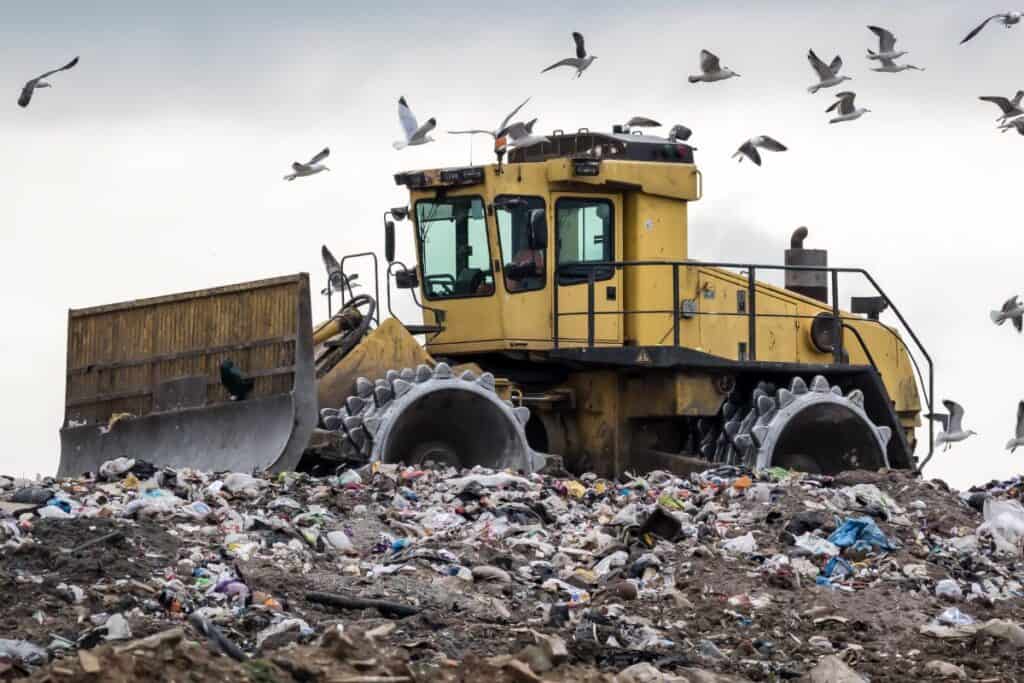Is solar panel recycling really possible, or is it just wishful thinking? Let’s pull back the curtain and reveal what happens to solar panels when their useful life comes to an end.
Solar panels are indeed recyclable. Once their productive lifespan, typically around 25 to 30 years, comes to an end, they don’t have to end up in a landfill. Although relatively new, the solar panel recycling industry is growing, tackling the rising number of decommissioned solar panels.
The solar panel recycling process is a fascinating, multistep procedure.
To begin with, solar panels are primarily made of glass, plastic, and metal, including valuable elements such as silver and silicon.
This composition allows a majority of the solar panel materials to be extracted and reused.

The initial step of recycling involves manually dismantling the solar panels to separate the aluminum frames and the glass layers.
Up to 95% of the glass and 100% of the metal frames can be reused. These materials are sent to specialized facilities for further recycling into new products.
The plastic components and the semiconductor materials which contain precious metals are treated differently.
These materials are heated to a high temperature, resulting in the evaporation of the small plastic parts.
This process leaves behind the semiconductor materials, which contain the precious metals.
The semiconductor materials are then treated with a variety of chemicals. This is to recover the valuable metals, such as silver and silicon, that were used in the production of the solar panels.
Recycling valuable metals found in solar panels
The extracted metals are repurposed and used in the production of new solar panels or other products.
The plastics, once evaporated, are also trapped and treated. This removes the harmful substances, allowing them to be transformed into a fuel source for certain industrial processes.
Unfotunately the infrastructure for recycling solar panels is not as widespread as it needs to be, particularly in the United States.
Most of the pioneering work in solar panel recycling is happening in Europe. Regulations there have been put in place to ensure that manufacturers are responsible for the recycling of their panels.
There is a need for similar regulations and infrastructure in the rest of the world. Considering the significant growth of solar energy generation, this is crucial.
With millions of panels set to reach the end of their lifespan in the next few decades the issue of recycling solar panels is one that will only grow in importance.
In conclusion, solar panels can be recycled, with many of the materials recovered for reuse.
The challenge is scaling up the infrastructure and regulations necessary to make solar panel recycling commonplace. Ensuring that these valuable materials are not wasted, and that solar power remains a truly sustainable source of energy.
So let’s dig into each of these aspects of solar panel recycling in more detail…
What parts of a solar panel can be recycled?
When it comes to the recyclability of solar panels, not all parts are created equal.
The truth is, however, that a significant proportion of a solar panel can be effectively recycled and used to create new products.
Solar panels are complex devices, composed of a variety of materials. These primarily include glass, metal, plastic, and semiconductor materials. Each of these materials has a different recycling process and potential for reuse.
The glass and metal, which make up the majority of a panel’s weight, are the easiest to recycle.
The outer glass layer, after being separated from the rest of the panel, can be recycled into new glass products.
Likewise, the aluminum frames are fully recyclable and can be melted down and repurposed into new metal products.
The ease and efficacy of these processes mean that up to 95% of the glass and 100% of the metal used in solar panels can be successfully recycled.
The story becomes slightly more complex with the plastic and semiconductor materials. These are found in the middle layer of the panel, sandwiched between the outer glass and the backing layer.
During recycling, this layer is heated to high temperatures, causing the plastic to evaporate and leaving behind the semiconductor materials.
Recycling semiconductor materials in solar panels
The semiconductor materials contain valuable metals like silver and silicon.
These are extracted through a series of chemical treatments, with the metals then repurposed into new solar panels or other products.
This process allows the majority of the valuable metals in a solar panel to be recovered and reused.
The plastic, once evaporated, is trapped and treated to remove harmful substances.
The resulting material can then be transformed into a fuel source for use in industrial processes.
In essence, the majority of the materials in a solar panel can be recycled. However, it’s important to note that the efficiency of recycling processes can vary and are still being improved.
Some of the plastic and semiconductor material may be lost during recycling. The majority of the panel by weight however can be effectively reused.
This makes solar panels not only a renewable source of energy but also, at the end of their life, a valuable source of recyclable materials.
The challenge is to ensure that the recycling infrastructure is in place to take advantage of this potential. Thus turning end-of-life solar panels into a resource rather than a waste product.
How are solar panels recycled, and what is the process involved?
Recycling solar panels is not as simple as tossing them in a bin and sending them off to a recycling plant.
Instead, it requires a multi-step process to ensure that each component of the panel is properly handled.
The goal is to recover as many reusable materials as possible and minimize waste.
The first step in recycling a solar panel is disassembly.
This is usually done manually and involves removing the aluminum frame and the junction box attached to the back of the panel.
These components are simple to recycle and can be processed to create new aluminum products and electronic components, respectively.
Next, the glass layer is separated from the rest of the panel.
How glass is removed in solar panel recycling
This is achieved by heating the panel to a temperature that breaks the bonds between the glass and the underlying materials.
The glass is then removed, crushed into smaller pieces, and can be recycled into new glass products.
Once the glass has been removed, the middle layer of the panel, known as the laminate, is exposed.
This contains a mix of plastic and semiconductor materials.
The laminate is heated in a furnace to a temperature that causes the plastic to evaporate, leaving behind the semiconductor material.
The remaining semiconductor materials, which include valuable metals like silicon and silver, are then subjected to a series of chemical baths.
These treatments dissolve the metals, allowing them to be precipitated out and collected. These recovered metals can then be reused in new solar panels or other electronic devices.
Finally, the plastic gases that were evaporated during the heating process are captured and treated to remove any harmful substances.
The remaining material can be used as a fuel source in industrial processes.
It’s worth noting that this recycling process is complex and requires specialized equipment.
Additionally, each solar panel model may contain slightly different materials and structures. This means the recycling process may need to be tweaked to ensure maximum recovery of recyclable components.
At present, not all regions have dedicated solar panel recycling facilities. As the industry continues to grow, it is expected that infrastructure will expand to manage end-of-life panels more effectively.
The recycling process of solar panels is a vital part of the renewable energy lifecycle. It ensures that even as panels reach the end of their useful lives, they continue to provide value and reduce waste.
Are there any specific facilities or programs that accept old or damaged solar panels for recycling?
Old or damaged solar panels are not your typical household waste that you can drop off at your local recycling center.
Specialized facilities and programs are needed to ensure these panels are recycled correctly, and these services exist, albeit in a limited capacity.
Several manufacturers of solar panels have established their own recycling programs. Companies like First Solar and SunPower have ‘take-back’ programs where they will accept old panels (even if they were not initially purchased from them) and handle the recycling process themselves.
On a larger scale, organizations like PV Cycle in Europe have implemented industry-wide initiatives for solar panel recycling.
PV Cycle offers a service where they collect end-of-life panels from drop-off points and transport them to specialized recycling facilities.
In the United States, the Solar Energy Industries Association (SEIA) initiated a national recycling program in collaboration with several waste management companies.
The program aims to enhance the sustainability of the solar industry throughout the entire lifecycle of solar products.
Some recycling facilities also specialize in handling electronic waste (e-waste), including solar panels.
These companies are equipped to safely extract the valuable materials from the panels and dispose of any hazardous waste.
Which companies recycle panels?
One such company is ERI, which has locations across the United States and provides a mail-back program for smaller solar panels.
While these initiatives are promising, the infrastructure for recycling solar panels is still developing, especially in areas with growing solar markets.
However, it’s encouraging to note that industry regulations are becoming more widespread.
For instance, the European Union’s Waste Electrical and Electronic Equipment Directive requires manufacturers of solar panels to finance the cost of collecting and recycling end-of-life panels.
It’s crucial to plan for the end of a solar panel’s life even as we celebrate the advancements in renewable energy.
As consumers and investors in solar technology, we can help drive the demand for robust recycling programs and responsible end-of-life management of these products.
This ensures that the solar industry remains sustainable, not only from an energy perspective but also from a materials standpoint.

Recycling solar panels versus disposing of them in a landfill
The environmental impact of recycling solar panels is far less severe than disposing of them in landfills, and it’s essential to understand why.
When solar panels end up in landfills, several issues arise. Firstly, precious and finite materials such as silver, tin, and silicon are wasted.
This is not just economically inefficient but also environmentally harmful. Extracting these materials requires substantial energy and can lead to habitat destruction and pollution.
Secondly, some components of solar panels, like lead or cadmium used in certain types of panels, can be hazardous if not properly managed.
Although these are encased in glass and are not a risk while the panel is in use, they could leach into the environment if the panel is broken or deteriorated in a landfill.
On the other hand, recycling solar panels mitigates these environmental impacts.
The process of recycling can recover up to 95% of the glass and 85% of the semiconductor materials which can be reused in the production of new panels or other products.
This reduces the need for raw materials and the energy associated with extracting and processing them.
Moreover, the recycling process itself is becoming more energy-efficient.
The improvement in recycling technology
With the advent of new technologies, the amount of energy required to recycle a panel is much lower than that needed to manufacture one from scratch.
In addition, the greenhouse gas emissions associated with recycling are substantially less than those from producing new panels.
However, it’s worth noting that while recycling is the better option, it’s not without its challenges. The process is complex and requires sophisticated technology and infrastructure.
But as the solar industry continues to grow, and more panels reach the end of their lifespan, it is expected that the recycling infrastructure will improve, and the process will become even more efficient and widespread.
In conclusion, recycling solar panels has a significantly lesser environmental impact compared to disposing of them in landfills.
It conserves valuable resources, reduces the release of hazardous substances, and decreases energy consumption and greenhouse gas emissions.
As solar power continues to surge in popularity, it’s imperative that the recycling of solar panels keeps pace to ensure the long-term sustainability of this vital renewable energy source.
Is there a cost associated with recycling solar panels?
There is, indeed, a cost associated with recycling solar panels. Understanding the details of these costs and their implications can provide clarity for those considering solar panel installation or replacement.
When it comes to recycling solar panels, costs can vary widely. It largely depends on factors like the size and type of the panel, the technologies used in the recycling process, and the geographical location. The market for recycled materials also plays a role.
The process of recycling a solar panel involves disassembling the panel, removing and segregating the different components, and then processing these components so they can be reused.
Each step in this process comes with a cost. For instance, transport costs to bring the panels to a recycling facility can be significant. Especially if facilities are few and far between.
Moreover, the technologies used for recycling are often complex and require a high initial investment.
This contributes to the overall recycling costs. There are also costs associated with handling and processing the hazardous materials that can be found in some types of solar panels.
On the other hand, there is a potential return from selling the recovered materials such as aluminum, copper, and silver.
Recycling costs are dictated by market forces
However, the market prices for these materials fluctuate, and their value may not always offset the cost of recycling.
Unfortunately, these costs can serve as a deterrent to recycling, particularly when compared to the often lower costs of landfill disposal.

This is why some regions and countries have implemented regulations requiring manufacturers to take responsibility for the end-of-life management of their products, a principle known as extended producer responsibility (EPR).
This policy shifts the recycling costs from the waste producer to the product manufacturer. This incentivizing them to design more recyclable products and establish efficient recycling programs.
In conclusion, while there are costs associated with recycling solar panels, they should be weighed against the significant environmental benefits.
With more advanced recycling technologies and effective policies, it’s expected that the costs will decrease over time. This will make recycling an increasingly accessible and attractive option for end-of-life solar panel management.
What are the challenges and limitations in recycling solar panels?
There certainly are a few challenges and limitations when it comes to recycling solar panels. To fully comprehend these, it’s important to consider the technical, economic, and regulatory aspects that influence the recycling process.
In the realm of recycling, solar panels pose a complex problem. The multi-layered composition of panels includes both valuable and hazardous materials that must be carefully separated to avoid contamination.
While technologies exist to perform this task, they can be costly and energy-intensive. This raises the question of whether recycling is the most environmentally friendly option.
Economically, the recycling process faces challenges as well. As already discussed, the costs associated with recycling can be high, while the revenues derived from selling recovered materials fluctuate with market conditions.
The lifespan of solar panels before they need recycling
Moreover, given that the majority of solar panels installed today will reach the end of their life in 15 to 30 years, the volume of waste is not yet large enough to achieve economies of scale in the recycling process.
This could limit the growth of recycling facilities and increase unit costs in the short term.
The location of recycling facilities poses another economic challenge.
If facilities are few and far between, transportation costs can significantly add to the overall cost of recycling. This also increases the carbon footprint of the recycling process.
From a regulatory standpoint, the lack of universal regulation surrounding the disposal and recycling of solar panels is a significant limitation.
While some regions have implemented producer responsibility laws, many places lack these regulations. This leaves it up to the panel owner to manage their disposal. In such cases, landfill disposal might be chosen over recycling due to cost considerations.
Furthermore, the presence of hazardous materials in solar panels, such as lead in some thin-film technologies, poses a health and environmental risk if not properly managed during the recycling process.
Without strict regulations and enforcement, there’s a risk these materials could be mishandled, leading to environmental contamination.
While recycling is the most environmentally friendly way to manage end-of-life solar panels, the process faces a number of technical, economic, and regulatory challenges.
Despite these limitations, the sector is evolving. With advancements in technology, increased regulation, and greater volumes of waste in the future, the economics of recycling solar panels are expected to improve, making it a more accessible and widely adopted practice.
How effective is the recovery of materials during the solar panel recycling process?
The effectiveness of material recovery during the solar panel recycling process can vary quite a bit. It is highly dependent on the recycling technologies in use, the type of solar panel being recycled, and the meticulousness of the process.
Here’s a more detailed look at how effective this recovery truly is.
When discussing solar panel recycling, it’s important to remember that there are different types of solar panels.
Crystalline silicon panels, the most common type, are made up of aluminum, glass, plastic, and a small amount of silver and silicon.
The thin-film panels, on the other hand, contain a variety of materials including cadmium, telluride, and copper indium gallium selenide.
Currently, for silicon-based panels, recycling processes can recover up to 95% of the glass and 85% of the metal, primarily aluminum.
The plastic layer is often used for energy recovery, though efforts are underway to improve the recycling of this component as well.
The hardest minerals to recover when recycling
The silver and silicon, however, are harder to recover due to their small quantities and the complex processes required for their extraction.
When it comes to thin-film panels, recycling technologies are capable of recovering up to 95% of the semiconductor material and 90% of the glass.
Despite these high recovery rates, it’s important to note that thin-film panels contain potentially toxic materials. Materials like cadmium which require careful handling to prevent environmental contamination.
While these recovery rates are impressive, they don’t provide the full picture.
The efficiency of material recovery is also affected by the fact that some materials, like silicon and silver, lose their quality during the recycling process.
This downgrading of material quality can limit the applications of the recovered materials. In turn this impacts the overall economic viability of solar panel recycling.
Furthermore, it’s worth noting that not all materials present in a solar panel are currently recoverable.
New technologies and methods are being developed to increase the range of materials that can be recycled from solar panels, but until these become widely available and economically viable, some materials will inevitably be lost during the recycling process.
Overall, while the material recovery rates in solar panel recycling are generally high, there are still improvements to be made.
There are significant efforts underway to increase the range of recoverable materials. This is done by improving the quality of recovered materials, and refining the processes to make them more cost-effective.
As these advancements come into play, the effectiveness of material recovery in solar panel recycling is expected to rise.
What happens to the toxic materials found in some solar panels during the recycling process?
It’s an unfortunate fact that some solar panels do contain toxic materials. However, during the recycling process, these substances are not just casually discarded.
They are handled with extreme caution to prevent any harm to the environment or human health.
Let’s delve into the specifics of how toxic materials in solar panels are managed during recycling.
The first step in recycling a solar panel involves disassembling it to separate the different components.
Here, components containing toxic materials, like the semiconductor layers in thin-film solar panels, are isolated.
These semiconductor layers can contain substances such as cadmium telluride or copper indium gallium selenide. Both of which are harmful if released into the environment.
After isolation, the toxic materials are carefully processed. The exact method depends on the specific substance in question.
For example, cadmium telluride is a toxic compound found in some thin-film panels. It can be processed using a combination of heat treatment and leaching.
This allows the cadmium to be safely separated from the tellurium. It can be reused or properly disposed of.
It’s worth noting that the treatment of toxic materials from solar panels is heavily regulated in many parts of the world.
Europe leading the way
In Europe, for instance, the Waste Electrical and Electronic Equipment (WEEE) directive sets clear guidelines for handling and recycling electronics, including solar panels.
Companies involved in recycling solar panels must comply with these regulations. They are also regularly audited to ensure they meet the required standards.
Despite these precautions, there are still challenges involved in managing the toxic materials in solar panels. For one, the recycling processes can be complex and expensive.
Furthermore, not all materials can be completely recovered or safely disposed of. Some residual waste is typically generated, which must be handled carefully to avoid environmental contamination.
In addition, the increasing volume of end-of-life solar panels is posing a significant challenge.
As more and more panels reach the end of their lifespan, the amount of toxic material needing to be processed is rapidly growing.
This is putting pressure on the recycling industry to continually improve their processes and capacity.
To conclude, the toxic materials in solar panels are treated with utmost care during the recycling process.
Though the process is complex and there are challenges to overcome. Stringent regulations and ongoing improvements to recycling technology are helping. This ensures these materials are managed in a way that minimizes harm to the environment and human health.
As the solar industry continues to grow, so too will the efforts to effectively and responsibly recycle solar panels and their components.
